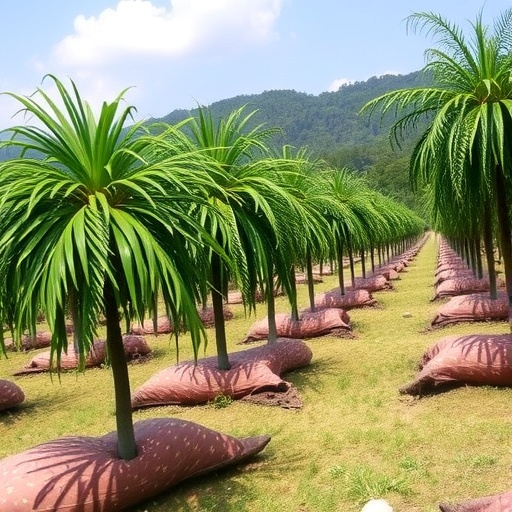In a groundbreaking study that sheds light on the diverse attributes of the Cinnamomum tamala species, researchers have embarked on an exploration into the morphological, physiological, and phytochemical variability of this evergreen tree. Specifically, the study targeted specimens cultivated in two distinctive community lands in the Almora district of Uttarakhand, India. This investigation is crucial, as it aims to uncover the broad spectrum of variations within a single species, which can offer insights into how local environmental factors and cultivation practices influence plant characteristics.
Cinnamomum tamala, commonly known as Indian bay leaf, is not just a culinary staple known for its aromatic properties; it holds significant medicinal value. Traditionally, the leaves of this tree have been utilized in various treatments, from digestive ailments to anti-inflammatory applications. The present research endeavors to better characterize this species by evaluating various parameters across different cultivation fields. The findings of this study could open pathways toward not only sustainable farming practices but also improved health benefits derived from this plant.
The research team, comprising Bahukhandi, Tiwari, Singh, and others, conducted the study by carefully selecting two community lands that presented contrasting environmental conditions. This strategic selection was vital for understanding the effects of soil quality, altitude, and microclimate on the growth and development of Cinnamomum tamala. As this species is adapted to a range of ecological zones in India, documenting variations across these specific locales is expected to yield valuable data that could inform cultivation in similar environments.
Under the lens of morphological variability, the researchers meticulously assessed traits such as leaf size, shape, and color. The visual differentiation among the leaves collected from both community lands exhibited compelling characteristics that hinted at the underlying genetic diversity. Observations suggested that environmental factors played a considerable role in shaping these morphological traits. For instance, variations in leaf size were notable, which could indicate adaptations to local climate conditions, such as sunlight availability and rainfall.
Physiological parameters were another focal point of the study, encompassing aspects such as growth rate, moisture retention, and overall health of the plant specimens. Researchers employed advanced measurement techniques to quantify these attributes, leading to intriguing comparisons between the two sites. Preliminary data revealed that certain plants in one community demonstrated enhanced growth rates, potentially due to superior soil nutrition or optimal water access. Such empirical evidence allows for a deeper understanding of the requirements for maximizing the yield of Cinnamomum tamala.
In addition to morphological and physiological assessments, the phytochemical analysis was a central component of this research. The leaves of Cinnamomum tamala are well-known for their rich profile of phytochemicals, which are essential for their medicinal properties. The study involved extracting various essential oils and assessing bioactive compounds present in the leaves. Results indicated significant variability in the concentration of these compounds between the two communities, with one locality displaying a higher abundance of certain phytochemicals that have been linked to enhanced therapeutic benefits.
Such findings underscore the importance of locality in determining the chemical makeup of the plant, thus advocating for site-specific cultivation strategies that could amplify both flavor profiles in culinary applications and efficacy in medicinal use. The implications are far-reaching, suggesting that farmers and herbalists could harness localized knowledge to optimize their harvest and better meet market demands.
In an era where sustainability is paramount, the conclusions drawn from this study can significantly influence conservation efforts and agricultural practices. By understanding the factors that lead to variability within Cinnamomum tamala, practitioners in agroforestry can employ strategies to maintain biodiversity, which is vital for ecosystem resilience. The research advocates for integrating traditional ecological knowledge with modern scientific approaches to promote sustainably cultivated medicinal plants that can thrive in their native habitats.
Moreover, the research emphasizes the potential for bioprospecting in the undeveloped regions of India. As interest in natural products grows, establishing a detailed understanding of Cinnamomum tamala could position local farmers and communities to benefit from emerging markets in traditional medicine and organic products. This could create pathways to economic stability while preserving cultural heritage associated with traditional plant usage.
As the scientific community looks toward future research avenues, the study encourages further exploration into other species within the Cinnamomum genus. Comparative studies among different species could yield insights into broader evolutionary patterns and adaptive mechanisms at play in diverse ecosystems within India and beyond. Such research could ultimately serve as a blueprint for conservational strategies aimed at preserving endemic plant species under environmental stressors.
This investigation serves as a reminder of the rich tapestry of life that exists in the Himalayan foothills, a region teeming with biodiversity yet fragile in the face of climate change and development pressures. The need for continued research cannot be overstated, as ensuring the survival of such species is crucial for maintaining the ecological balance while also supporting human livelihoods.
In conclusion, the study of morphological, physiological, and phytochemical variability in Cinnamomum tamala cultivated in different community lands underscores the intricate relationship between plants and their environments. The findings illuminate the potential for enhanced agricultural practices and informed conservation efforts, all of which contribute to the sustenance of local communities and the health of the planet. As researchers delve deeper into the complexities of plant biology, the lessons learned from Cinnamomum tamala may have far-reaching implications for food security, health, and environmental stewardship across the globe.
Subject of Research: Variability in Cinnamomum tamala
Article Title: Morphological, physiological and phytochemical variability in Cinnamomum tamala cultivated in two different community lands in Almora district, Uttarakhand, India.
Article References:
Bahukhandi, A., Tiwari, D.C., Singh, B. et al. Morphological, physiological and phytochemical variability in Cinnamomum tamala cultivated in two different community lands in Almora district, Uttarakhand, India. Discov. Plants 2, 255 (2025). https://doi.org/10.1007/s44372-025-00340-y
Image Credits: AI Generated
DOI: 10.1007/s44372-025-00340-y
Keywords: Cinnamomum tamala, morphological variability, physiological variability, phytochemical variability, community lands, Almora, Uttarakhand, sustainable agriculture, biodiversity, medicinal plants.




